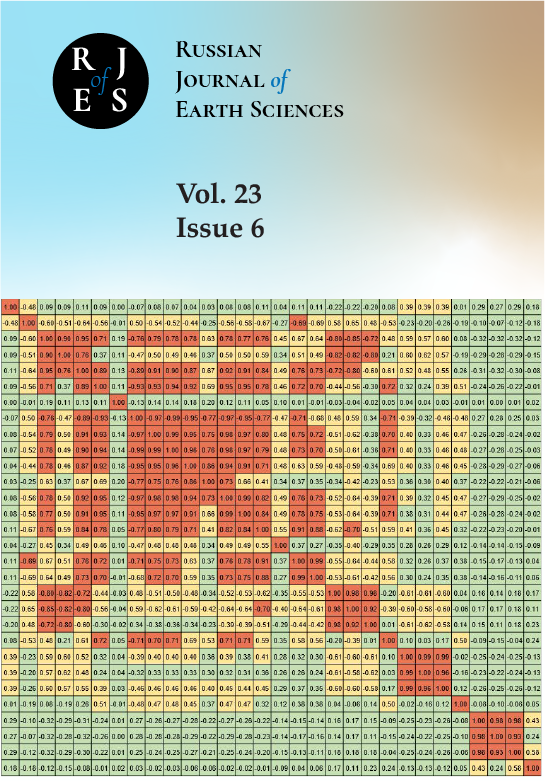from 01.01.2022 to 01.01.2023
Lomonosov Moscow State University
from 01.01.2019 to 01.01.2023
Moscow, Moscow, Russian Federation
UDC 53.05
UDC 53
UDC 55
UDC 550.34
UDC 550.383
CSCSTI 37.01
CSCSTI 37.15
CSCSTI 37.25
CSCSTI 37.31
CSCSTI 38.01
CSCSTI 36.00
CSCSTI 37.00
CSCSTI 38.00
CSCSTI 39.00
CSCSTI 52.00
Russian Classification of Professions by Education 05.00.00
Russian Library and Bibliographic Classification 26
Russian Trade and Bibliographic Classification 63
BISAC SCI SCIENCE
The article is devoted to the spatial distribution of the average productivity of earthquakes in the main part of Japan for the period 2000–2020. The maps were generated with The Generic Mapping Tools using the Japan Meteorological Agency catalog for earthquakes 40 km below the surface. We are talking about «crustal» earthquakes on the island part of Japan. Maps were built for the period 2010–2020, where the radius (25 km, 50 km, 100 km), catalog completeness (1 and 1.5) and ∆𝑀-productivity (1 and 2) were varied. For the most indicative map, the stability of the picture in time was checked. An attempt was also made to test the effect of surface heat flux on the distribution of average earthquake productivity.
Earthquake productivity law, nearest neighbor method, heat flow, Japan
1. Baiesi M., Paczuski M. Scale-free networks of earthquakes and aftershocks // Physical Review E. — 2004. — Vol. 69, no. 6. — P. 066106. — DOI:https://doi.org/10.1103/PhysRevE.69.066106. EDN: https://elibrary.ru/WBXIIG
2. Cheng, Ch., Hui C., Yang J., et al. The relationship between heat flow and seismicity in global tectonically active zones // Open Geosciences. — 2020. — Vol. 12, no. 1. — P. 1430–1439. — DOI:https://doi.org/10.1515/geo-2020-0195.
3. Marsan D., Lengliné O. Extending Earthquakes’ Reach Through Cascading // Science. — 2008. — Vol. 319, no. 5866. — P. 1076–1079. — DOI:https://doi.org/10.1126/science.1148783. EDN: https://elibrary.ru/XXAAVU
4. Pisarenko V. F., Skorkina A. A., Rukavishnikova T. A. Application of New Statistical Methods to Estimation of the Seismicity Field Parameters by an Example of the Japan Region // Izvestiya, Physics of the Solid Earth. — 2023. — Vol. 59, no. 6. — P. 967–978. — DOI:https://doi.org/10.1134/S1069351323060162. EDN: https://elibrary.ru/GIXQNJ
5. Shebalin P., Baranov S., Vorobieva I. Earthquake Productivity Law in a Wide Magnitude Range // Frontiers in Earth Science. — 2022. — Vol. 10. — DOI:https://doi.org/10.3389/feart.2022.881425. EDN: https://elibrary.ru/EKNRKP
6. Shebalin P. N., Narteau C., Baranov S. V. Earthquake productivity law // Geophysical Journal International. — 2020. — Vol. 222, no. 2. — P. 1264–1269. — DOI:https://doi.org/10.1093/gji/ggaa252. EDN: https://elibrary.ru/IHQXAK
7. Utsu T. Aftershocks and earthquake statistics (II): Further investigation of aftershocks and other earthquake sequences based on a new classification of earthquake sequences // Journal of the Faculty of Science, Hokkaido University. Series 7, Geophysics. — 1970. — Vol. 3, no. 4. — P. 197–266.
8. Vorobieva I. A., Gvishiani A. D., Shebalin P. N., et al. Integrated Earthquake Catalog II: The Western Sector of the Russian Arctic // Applied Sciences. — 2023. — Vol. 13, no. 12. — P. 7084. — DOI:https://doi.org/10.3390/app13127084. EDN: https://elibrary.ru/UFUMJT
9. Wessel P., Luis J. F., Uieda L., et al. The Generic Mapping Tools Version 6 // Geochemistry, Geophysics, Geosystems. — 2019. — Vol. 20, no. 11. — P. 5556–5564. — DOI:https://doi.org/10.1029/2019gc008515. EDN: https://elibrary.ru/JFOOHN
10. Zaliapin I., Ben-Zion Y. A global classification and characterization of earthquake clusters // Geophysical Journal International. — 2016. — Vol. 207, no. 1. — P. 608–634. — DOI:https://doi.org/10.1093/gji/ggw300.
11. Zaliapin I., Gabrielov A., Keilis-Borok V., et al. Clustering Analysis of Seismicity and Aftershock Identification // Physical Review Letters. — 2008. — Vol. 101, no. 1. — P. 018501. — DOI:https://doi.org/10.1103/PhysRevLett.101.018501. EDN: https://elibrary.ru/NGWIWD
12. Zhuang J., Ogata Y., Vere-Jones D. Stochastic Declustering of Space-Time Earthquake Occurrences // Journal of the American Statistical Association. — 2002. — Vol. 97, no. 458. — P. 369–380. — DOI:https://doi.org/10.1198/016214502760046925.














